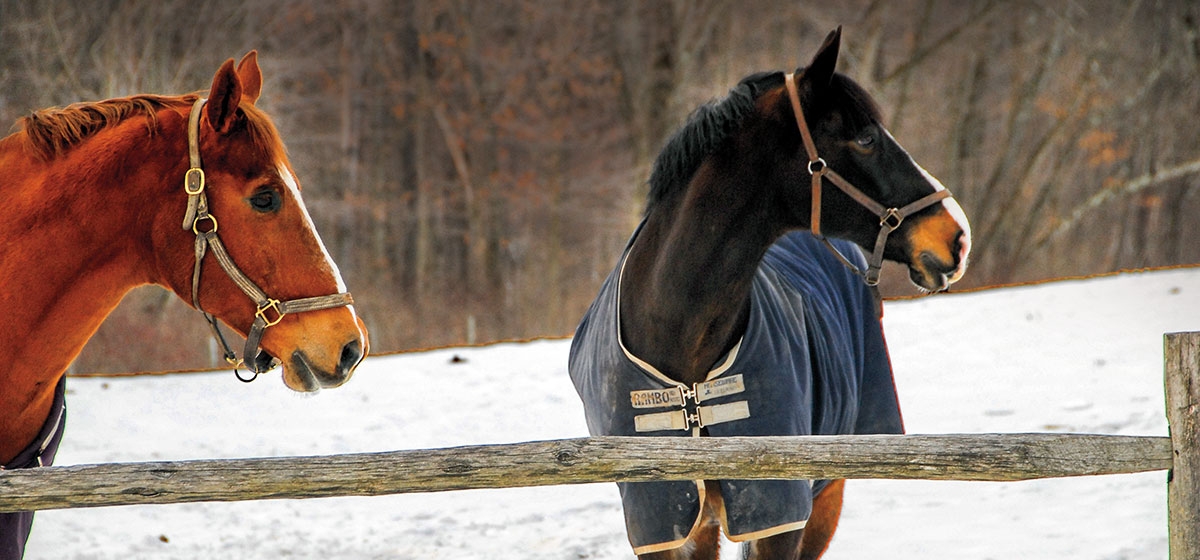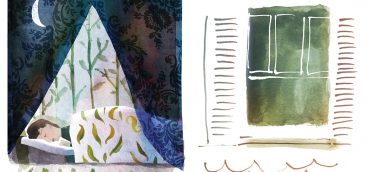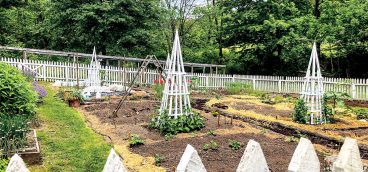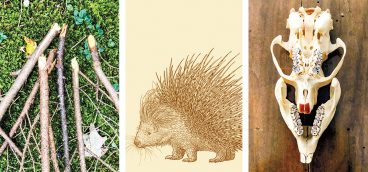Trying to Save a Horse

There have been phone calls in my life I wish I’d never received. I was cold and wet from swimming in an Irish lake when I returned to the house to see my husband standing in the driveway. Waiting for me. That wasn’t normal. My father had called. My mother was dead. She was unloading the dishwasher when an aneurysm burst.
One night about three years ago, after my plane landed in Florida and taxied to the terminal, I opened my cell phone and heard a message from my husband. Our son had had a bad accident. “Not life threatening, but not good,” he said.
Last winter at dusk I was just slipping my feet into my muck boots to go close the chicken coop when my cell phone rang. It was Dave, who helps with our horse. “Hershey has fallen on the ice.”
I’d worried about a horse falling on ice on our driveway for 30 years. To get from barn to pasture and back again, horse and leader must traverse blacktop, which can be treacherous in winter. On the iciest spots we sprinkle sand or wood ash and lead the horses out the back door of the barn where there’s more grass and less blacktop, but still, blacktop is unavoidable. We’ve tried to change the path, but the configuration of our property—barn, house, stream, bridge, driveway and lawn—makes it impossible. Winter poses another problem: ice and snow accumulate under Hershey’s hooves while he’s in the pasture, and unless we lift each of his legs and knock the ice off with a mallet before bringing him inside, he might as well be skating down the driveway with icy tennis balls on his horseshoes.
I found Dave and our 1,800-pound Clydesdale/Thoroughbred cross on the ground in the middle of the driveway. Dave’s girlfriend’s horse, Frankie, was loose and needed to be taken to the barn so I grabbed him and walked as gingerly as I could. On icy days I worry about myself too—or whomever is holding the lead rope. If a horse falls on the ice, it’s likely the human is going with him. (Dave was lucky that night; his feet slid out from under him, but he caught his balance somehow on the lead rope.) Frankie and I made it safely to the barn and I tucked him into his stall; I put our two dogs in another stall so they wouldn’t be underfoot. I went back to Dave, still on the ground with Hershey.
“Hi, my Hersh,” I said softly, the same nickname and tone I always use. “Hi, my Hersh Hersh.” When he heard my voice, he looked up at me and made a valiant effort to stand, legs flying and body writhing, but he couldn’t. He stopped trying, lay there, and moaned.
“I think it’s his right rear ankle,” Dave said.
Dave and I were the only two on the farm that night and the least knowledgeable horse people. But I did know horses can’t stay down long. “When a horse goes down, time is of the essence,” Connie, our vet, said. We needed help and we needed it fast.
I called Connie, but she’d just had a baby and wasn’t on call. Her office said they’d try to send Anita, another vet, and Kami, the vet tech, as soon as possible. I called our friend, John, an excavator by trade and an Irish horse-whisperer of sorts, who, by the grace of some higher being, had returned from South Carolina at 3 a.m. the night before. He said he’d be right over. He suggested I call another fellow, Kevin, for an extra pair of hands, which I did.
I tease my husband that he’s never at the farm when the real disasters occur, but that’s not fair. He’s been home for his share of fires, floods and dying dogs, but the night Hershey went down, he was at a board meeting at a local university 40 minutes away. That was all I knew. Not where he was meeting or with whom. I knew he’d have his cell phone turned off, so I called the campus police. A nice woman answered who, to my surprise, recognized my name; her daughter had been in Pony Club with our daughter. When someone else located my husband, she told him the police were looking for him. I can imagine his eyes widening. He left the meeting and headed to the farm.
My husband bought Hershey 19 years ago in Virginia. A big-boned, gentle giant of a gelding, Hershey is 27 now, dark brown and black, with a white blaze on his nose. Three out of four of his furry feet are white. The fourth is black. Hershey was head-shy when he first arrived, abused in some way we figured, but in no short time I taught him to give me horse kisses when I offered carrots. “Kisses,” I’d say, and he always complied. Sometimes he nearly knocked my teeth out, but I found joy when his big muzzle came my way. His eyes are a deep penetrating black, his tail thick, wide and long. And he’s a character: he leans out of his stall to nuzzle with the dogs, and in summer positions his head toward the fan, his black forelock sweeping backward so he looks like Elvis Presley. He’s one of the few horses that ever made me feel comfortable on his back.
I am the family member who came late to horseback riding, beginning lessons when I was 40 with my son, then 5. He and I took lessons together in Ireland in a small, sloppy riding ring, head to tail with a slew of other nags, nearly always in the rain. (If you don’t ride in the rain in Ireland, you don’t ride.) The conditions weren’t ideal, but our teacher was good and we learned a lot. Eventually I jumped three feet and galloped across our fields, but I never got over my fear completely. My husband, on the other hand, has ridden his entire life, and at 4, our daughter was fox hunting on a pony on a lead line behind him, flying over jumps, begging to go faster and higher. She came home afterwards to drink milk out of a baby bottle. Over many years in Pony Club, she rode two fiery ponies—and Hershey.
Dave and I waited in the frigid dark with only a flashlight and light from our cell phones. Dave didn’t have gloves on, but wouldn’t let me relieve him. He insisted on staying on the ground next to Hershey, trying to calm him. I paced and kneeled down periodically to rub Hershey’s neck. “It’s alright, Hersh,” I said. Over and over. Occasionally, Hershey tried again to get up, but again, he failed. He kept moaning. We heard Frankie whinnying in the barn, annoyed at being left alone. There was no visible moon or stars; when I looked up that night it was only to say a silent prayer to save our horse.
I could see it all play out in my head. Hershey had broken a bone. Help would arrive, but the only option would be to put him down. Lethal drugs would come out of the vet’s truck and Hershey would be given a shot. I’d have to stand there and watch him die. I’d be a mess but would try to hold it together. After the medicine took effect, we’d pick up Hershey in the tractor bucket and set him at a burial site. It would all happen too fast and not fast enough.
That wasn’t just my grim imagination, but the likely outcome. John told me his first thought when I called him was: “I am going to go meet a vet, and dig a hole.”
Our large, white and green 19th-century barn was not used for horses by the previous owner, but when we bought the farm, my husband insisted on animals. “Brings the fields alive,” he said. How right he was. We built stalls and a turnout shed and fixed up a smaller barn for cows. We’ve had five belted Galloways (“Oh, you have the Oreo cows,” strangers always said to me) and a motley crew of goats, sheep, chickens, geese, turkeys, rabbits, dogs, barn and house cats, horses and ponies. Hershey is our last large animal, and I couldn’t imagine our farm without him.
But if Hershey couldn’t stand, he’d likely be dead in a matter of hours. His massive weight compressed his lungs and heart, so eventually he’d struggle to pump blood to his extremities, resulting perhaps in “compartment syndrome” where muscle tissue dies from lack of blood, Connie explained. His size was not to his advantage; ponies can stay down longer because they weigh less. “Horses need to get up, roll around, shake, and then they can go back down,” she said.
Hershey couldn’t get up for two reasons. First, his legs pointed uphill so he couldn’t get his legs underneath him in order to stand. Imagine falling on the ski slope and your feet are uphill. Second, he couldn’t get any traction on the ice.
Headlights came down the driveway. Dave’s girlfriend, Elle, was first. She parked her car up high as a signal to others to stop and so as not to spook Hershey with her headlights. She sprinkled ash around Hershey to offer traction, and brought food and water, “to give him some energy, rehydrate if he’s tired,” she said. Hershey ate a bit of grain out of her hand, but couldn’t eat out of a bucket. John came next, then Anita and Kami—both of whom also had been in Pony Club with our daughter. Kevin arrived, now seven of us in all.
I sensed John had ideas about how to handle the situation, but he deferred to the vet. Anita examined Hershey’s legs and pelvis, and felt his pulses. She didn’t think anything was broken, but was concerned he might have fractures on the leg he was lying on. John watched Anita and noticed Hershey was able to help her, a good sign that his legs still had strength to move. John examined Hershey. “I asked all his legs to move, and they did,” he said. He concluded also that no bones were broken, but no one was positive.
John had a plan. We’d move Hershey by attaching one end of a strap to Hershey’s front leg and the other end to the front bumper of Kevin’s pick-up truck—a risky strategy that could harm Hershey more. But his rationale was: “Where are we now? We’re at zero. If we’re at zero, anything I try, even if it fails, I am still only at zero. Nothing is worse than zero.” The vet, he said, had one tool in her toolbox: a syringe. And no one wanted to use that.
It could be dangerous for us too. Horses can panic when they feel trapped, their fight or flight mechanism kicks in, and they flail and kick. (Anita and Kami, I found out later, were pregnant.) To prevent injuries, John asked that we follow his direction only, that no one else shout commands. I remember thinking I might scream, but I certainly wasn’t yelling out any orders. We complied, were quiet, and we watched.
The strap was attached to Hershey’s leg and to Kevin’s truck. Kevin got behind the wheel. John asked Dave to move from his perch still next to Hershey’s head, but Dave didn’t want to budge. John insisted, I backed him up, and finally Dave agreed. I sensed that Dave felt Hershey’s fall was his responsibility and wanted to stay close, which he later confirmed.
Kevin backed up the truck. “Just go easy,” John told him, using hand signals to guide him. Kevin dragged Hershey slowly off the tarmac. We were fortunate Hershey had a blanket on, which helped him slide, prevented hair scraping off, and kept him warm if he went into shock. And we were lucky Hershey was a warmblood, not a Thoroughbred. “A Thoroughbred would commit suicide before he’d let us help him,” John said. “They hit the panic button and everything goes wrong.” But Hershey allowed us to do whatever we could to help him.
“Hershey spun like a helicopter,” John said.
Now Hershey lay on a thin sliver of grass next to a stream, his head above his legs. But we had another problem: his feet needed to be flipped over so he’d have better traction.
This time, John attached the strap to one of Hershey’s bottom back legs and asked the other two men to get on one side of the horse with him. John gave each man an escape plan—where to run after the flip to avoid getting hurt. “We were in the most dangerous place in the world,” John said later, with a horse’s legs spinning toward them and not much room to move. “If Hershey jumped up, staggered and fell, he was falling on top of us.”
John gave a command and Hershey’s legs flipped. I heard what I thought was a gunshot. I jumped. But it wasn’t a gun. John had whacked Hershey’s flank with the strap, hitting the horse blanket and making a deafening sound.
“I needed to make Hershey think it was a shotgun going off,” John said. “He needed to use every sense he had in his mind and body to leave town.” It was a split-second decision. “You only get one chance to scare the bejesus out of him.”
“He got Hershey at the right angle,” Anita said later. “Horses want to run away from pain and scariness and noises and such. He got him moving, that’s for sure.”
Hershey shot upright, standing on all fours.
None of us could believe it. I think we all exhaled at the same time.
We walked Hershey back and forth across the grass so Anita and John could assess his condition. Stiff, but sound, they concluded. Anita gave him a painkiller and an anti-inflammatory in case he was sore. We brought Frankie back out from his stall and put both horses in the pasture for the night. Anita and John agreed that Hershey should stay out of the stall and keep moving so his muscles didn’t freeze up.
“I’ve never had a situation turn out so well,” Kami said.
“Hershey’s a legend,” Anita said. He had long been one of the most popular horses in Pony Club, and that night he showed his mettle again.
I walked over to John and threw my arms around his neck, a bit too bold perhaps as I didn’t know him that well. But I was so grateful. I thanked everyone who came out of their warm houses and offices on a freezing evening to save the life of a horse.
Hershey was skittish for a couple days. He didn’t want to come into the barn,or walk on that driveway again. When Anita came back the next day to check on him, Hershey wouldn’t come to us, even though we had a bucket of feed. He ran in the other direction—proof enough he was truly all right.
“Really, honest to goodness, it was pure luck that my attempt worked,” John said. He gave the rest of us credit for making the night successful: for keeping Hershey relaxed, for staying focused, for having a vet there, which gave him comfort. “It was good to get a licensed second opinion,” John said.
But I know differently. Without John, we would have lost our beloved horse.





